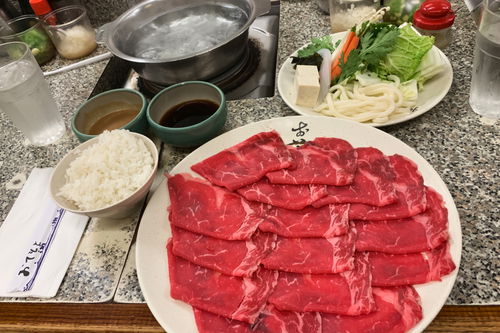7 have already made this dish!
The preparation:
-
First prepare the sauce. Mix sake, mirin, sugar and soy sauce in a small saucepan and bring to a boil. Once the sauce is boiling, remove it from the heat.
-
Prepare the udon noodles according to the package instructions. Also prepare the shirataki noodles according to the instructions.
-
Now it's time for the remaining ingredients: Cut the cabbage lengthwise into small rectangles. Also cut shungiku and spring onions.
-
Now cut the enoki mushrooms.
-
The tofu is also cut into cubes.
-
The carrots are cut into slices.
-
Kansai Method:
-
Now heat oil in a large skillet or pot and add the beef.
-
Sprinkle some brown sugar over the meat and pour some of the prepared sauce over it.
-
Turn the beef over so that it is well browned on both sides.
-
Now add the remaining sauce (about 320 ml) and dashi (240 ml) to the pan.
-
Now add the remaining ingredients. Start with the ones that need the longest cooking time. (The noodles are added last)
-
You can also add the meat unseasoned to the stew at the end, like with shabu shabu.
-
Cover the pan and bring the sauce to a boil. Now reduce the heat and simmer until the ingredients are cooked through.
-
Done! You can eat directly from the pot and add more ingredients as space allows. Add sauce and/or dashi to season the sukiyaki.
Table of contents:

What kind of broth is used for Sukiyaki?
A sweet and savory, very flavorful broth based on soy sauce is used.
What are the differences between Shabu Shabu and Sukiyaki?
Traditionally, Shabu Shabu is cooked in a special clay pot called Donabe. Sukiyaki, on the other hand, is cooked in an iron pot. Another difference is the cooking process itself: In Shabu Shabu, the ingredients are cooked in the broth. With Sukiyaki, however, the beef is fried in the pot before the remaining ingredients are added. The meat for Shabu Shabu is also cut much thinner than for Sukiyaki. The other ingredients (leaf vegetables, tofu and mushrooms), however, are very similar in both dishes.
Sukiyaki in Kansai vs. Kanto style
In Kansai (the area around Osaka), the meat is fried first and seasoned with sugar, soy sauce and sake, and some of it is also eaten as an appetizer. In Kanto, on the other hand, the Sukiyaki sauce is prepared first, and then all the ingredients are cooked simultaneously in the sauce.
What ingredients are in Sukiyaki?
In addition to meat and sauce,
- Chinese cabbage
- Shungiku (a Japanese herb used in many winter stews)
- Mushrooms (Enoki and Shiitake)
- Noodles (Udon and Shirataki)
- Tofu
- Spring onions
are used.
Tip: Many ingredients are typical Japanese. If you can’t find them anywhere, you can also replace them with western ingredients. Instead of Shirataki noodles, for example, you can use vermicelli, and also use seasonal mushrooms, spinach or bok choy.
Tips for the meat
The meat for Sukiyaki should be relatively thinly sliced. It is best to ask your butcher to do this for you. Otherwise, you can also use this trick: Freeze the meat, and then cut it into thin slices while it is semi-frozen. This usually works very well too. Buy meat pieces that are marbled with fat. Otherwise, the meat will often become tough after cooking.
Authentically: Sukiyaki with raw egg
In Japan, the cooked Sukiyaki ingredients are often dipped in a raw egg before eating. Be careful, though: While it is not a health concern in Japan to eat raw eggs, we would not necessarily recommend it in Germany!



Comments
Ich suche unter anderem nach gesundem Essen, und ich vertrete die Meinung, dass die chinesische und japanische Küche\r\ngesünder als die westliche (europäische) Küche ist.
Klingt super, werde ich demnächst so machen. Aber eine Frage: Ergibt das nicht ein bisschen viel Sauce? 4 Liter für 4 Personen? Es ist nicht leicht guten Mirin zu bekommen bei uns, und er ist recht teuer, deswegen frage ich. Und was sich mich noch Frage: - Wenn eine Person eine Alkoholunverträglichkeit hat, kann ich dann den Sake reduzieren ohne dass der Geschmack allzu leidet? - Nimmt man traditionell eine fischbasierte Dashi (z.B. Bonito), oder ist Kombu-Dashi auch ok? - Warum würdest du in Deutschland vom Ei eher abraten, gibt man da in Japan einfach mehr acht? Ich bin aus Österreich, aber ich hätte den Eiern bei uns einfach mal vertraut. Nur aus Interesse. Danke
Wirklich 450 g Fleisch, eine Packung Tofu, 1/2 Chinakohl plus Brühe, Pilze und Gemüse? Für jeden?